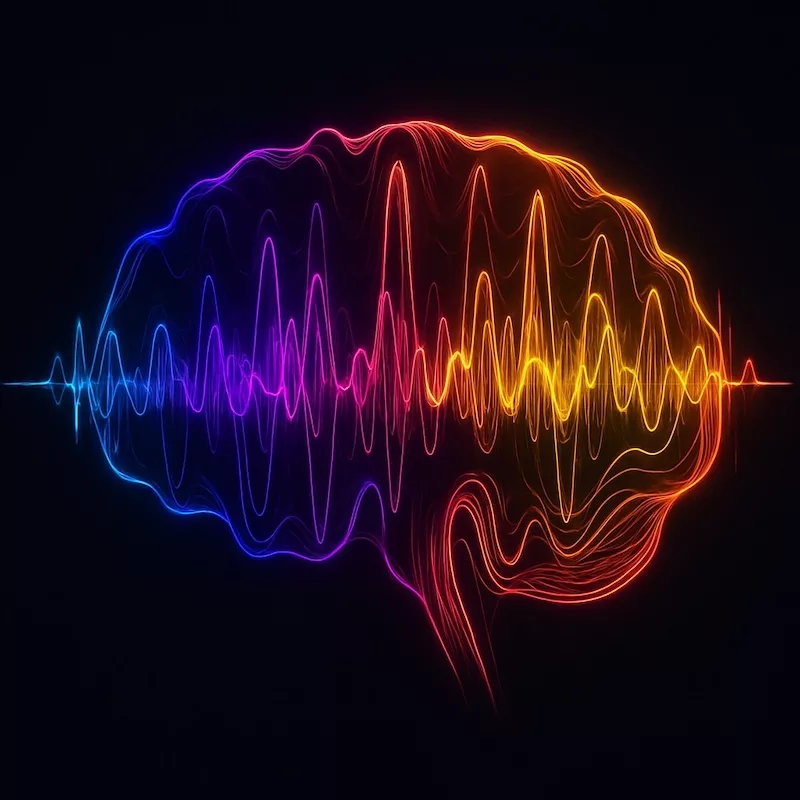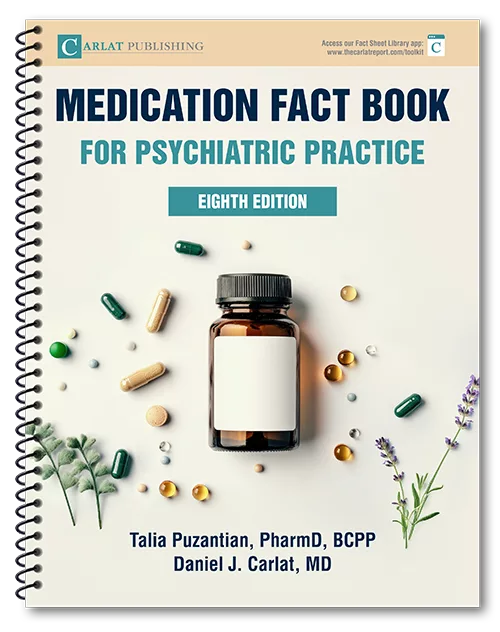Do TMS and psychotherapy share a common mechanism? We talk with Owen Muir about how to engage patients with this magnetic therapy.
Publication Date: 11/03/2025
Duration: 18 minutes, 43 seconds
Transcript:
OWEN MUIR: So, on a great day, your brain is firing in a rhythm. In every wonderful memory you've ever had, your brain is firing in a rhythm that feels good, that's being in sync, and so the ability to resynchronize your brain so that you can get back into your life, and you can feel in sync with the world, that generally lands with people, and it has the benefit of being true.
KELLIE NEWSOME: Welcome to The Carlat Psychiatry Podcast, keeping psychiatry honest since 2003.
CHRIS AIKEN: I'm Chris Aiken, the editor-in-chief of The Carlat Psychiatry Report.
KELLIE NEWSOME: And I’m Kellie Newsome, a psychiatric NP and a dedicated reader of every issue.
CHRIS AIKEN: In the summer of 2024, I set out to write a book about treatment-resistant depression. I thought I had the material covered – over the past 25 years, I’ve tried novel medications and behavioral therapies for patients who didn’t respond to anything. Pramipexole, celecoxib, minocycline, Omega 3, and ketamine-assisted psychotherapy. But the book took me down a different path, as new trials came out suggesting that medications may not be the most effective way to get people out of these thick and difficult depressions. Trials like ASCERTAIN-TRD, which showed us what many have suspected from meta-analyses all along: TMS (Transcranial Magnetic Stimulation) is more effective than adding aripiprazole to an antidepressant. They randomized 278 patients with treatment-resistant depression into three groups. The first got TMS, the second got aripiprazole augmentation, and the third were switched to an SNRI, like venlafaxine or duloxetine. The switch group served almost like a placebo, because switching antidepressants after two have failed to work is generally no better than placebo. At the end of the 2-month trial, only TMS was better than switching. Aripiprazole may hold the record as the most effective antipsychotic for antidepressant augmentation – a record based on its effect size and volume of trials in true treatment resistance – but aripiprazole barely beat antidepressant switching – eeking out only a non-significant trend. That study was followed by a Dutch trial that arrived at the same result, where TMS beat standard pharmaceutical strategies, like augmenting with lithium, or switching to nortriptyline. TMS is clearly turning up the volume on efficacy, but researchers were also modifying the magnet to change the game altogether. Those modifications – called accelerated TMS – culminated in the FDA-approved SAINT protocol in 2022 – bringing 70-90% of those with high levels of treatment resistance to full remission, unprecedented. When I ran a TMS service, I saw a hint of this difference. The recoveries I saw on TMS were different than those on medication. The patients weren’t just symptom-free. They seemed to function better. There was more back and forth in our conversations, more genuine range of affect, their thinking more complex and nuanced. They could see things in perspective and weren’t as burdened by stress. But I learned something else on that service. As good as these recoveries were, it was very hard to get patients to try TMS. Our esketamine clinic had a long wait list, but the TMS room had empty chairs. The insurance authorizations went comparatively smooth, but the patients were harder to convince. Some thought the magnet was a new-age scam. Some thought it was dangerous, some thought it was ECT with a new name. Others felt they were too depressed to show up five days a week for treatment. So, I spoke with Owen Muir about how he handles these conversations. Owen is the Chief Medical Officer at Radial, a practice that specializes in interventional therapies for difficult-to-treat disorders, with branches in New York, South Carolina, Tennessee, Missouri, and California. It wasn’t the conversation I expected, as we slipped into tangents of music, dance, evolution, and friendship, but these weren’t just tangents. They tell us about how TMS works, and even more about the experience of depression. We are still living in a med-centric world, and our patients come to us from that world. So how do you explain TMS in a way to patients that makes it sound not so weird, makes it sound like something that is an everyday treatment for depression?
OWEN MUIR: The most important thing is to spend the time to understand your patient's perspective and what they're going through, because then you can frame whatever you're offering in the context of their life. One of the things that Dr. Williams likes to say is that having a heart attack is as impairing (when you look at disability) as severe depression; and so literally having a heart attack right now, being in the middle of a heart attack in this conversation, and having severe depression are equally impairing in terms of what you can do in your life. Your ability to clean up the room, or pick up your laundry, you know, go to the bathroom, and shower appropriately. All those things are just as impaired in severe depression as they are in having a heart attack right now.
CHRIS AIKEN: Okay, so I'm thinking of a patient with chronic depression, and he attributes it to divorce, job loss, the way that people have mistreated him throughout his life, you know, a lot of valid social causes there.
OWEN MUIR: And his explanation isn't necessarily wrong, but we may be able to offer something that could help get him back on track.
CHRIS AIKEN: So, how would you explain TMS to him in a way that makes sense?
OWEN MUIR: I think the heart is something that we know what to do, right? And so, we have medicine to control your heart rate. If your heart's racing, you're going to feel bad. So, I'm going to give you a medicine that's going to slow down your heart rate. People understand that I think of depression as a brain rhythm problem, and we're going to get your brain back in sync with itself, and TMS is a way to create a rhythm in your brain that's healthy. When you talk to somebody and it's going well, we use words like, I feel so in sync with you, this feels like we're on the same wavelength. I think those things are literally true. I think we are in training to each other. Our brain rhythms are syncing up. When we're dancing together, it feels good, when we're playing in a band it feels good; when we're singing together it feels good. Everything humans love is about being in sync with each other. Good feelings in life, that's being in sync. And so, the ability to resynchronize your brain with itself, so that you can get back into your life, and you can feel in sync with the world, that generally lands with people, and it has the benefit of being true.
CHRIS AIKEN: True. So, is that what these stimulations are doing? These magnetic pulses.
OWEN MUIR: The magnetic pulses are inducing electrical signals in your brain, just like everything else in your life does. So, on a great day, your brain is firing in a rhythm. In every wonderful memory you've ever had, your brain is firing in a rhythm that feels good. Your brain feels good when the rhythm is right. TMS is using an external rhythm generator to get your brain back in sync with itself.
CHRIS AIKEN: Is that what psychotherapy is doing as well?
OWEN MUIR: You got it.
CHRIS AIKEN: And how does psychotherapy do that?
OWEN MUIR: Well, TMS doesn't work because your brain doesn't fire in a rhythm, right? We have our brains, which evolved in a world full of information that we can either get in sync with or stay out of sync with if it's dangerous. Psychotherapy is a way to resynchronize our brain to a social interaction with somebody who's exquisitely attuned to our experience and can adjust their responses, such that ours move along with them. It's tremendously powerful. It's some of the most powerful healing we have because we evolved to feel better or feel worse based on our interactions with others. And when our therapist tunes into us, we tune into ourselves and can bring that out into the world with us. It's actually remarkable.
CHRIS AIKEN: I get it. And I'm thinking about the words of Nick Drake, the songwriter who had terrible depression, and he wrote A movement in your brain, sends you out into the rain. I'm wondering, Owen, do you find that people with depression feel this way, that they feel the depression is like being out of sync or being disconnected in some way with the sink of the world around them?
OWEN MUIR: I've listened to enough music in my life to know in my bones that there is something profound in the experience of depression that tells us we don't fit, it's not right, something's wrong. It's so hard to put your finger on what it is that it inspires artists to try to depict in so many different ways what exactly is wrong in a way that others will find accessible, and they do a great job based on how much I love those songs and how well they do on the radio. I think these are shared experiences.
CHRIS AIKEN: So, Nick Drake is pretty articulate, but I imagine, maybe for the average patient, they're just saying this feels like anxiety. Like anxiety feels out of sync.
OWEN MUIR: Feeling anxious is a warning to not get too close because something might be out of sync or out of tune with somebody else, right? We feel that things could be off dissonant, and so we avoid. Anxiety is a warning that things might sound so wrong that we don't want to chance it. I suspect all of the effective treatments we have for depression are resynchronizing the brain with itself.
CHRIS AIKEN: So, electrically resynchronizing the rhythm of the brain.
OWEN MUIR: It's true for therapy. It's true for probably oral medications, they allow this resynchronization, and it's definitely true for the only thing that TMS is doing, which is stimulating the brain to fire more; and in DBS, specific neurons are being forced to fire or not fire more depending on the stimulation pattern. We're changing how circuits in the brain fire, and that gets people well.
KELLIE NEWSOME: Owen just compared TMS to DBS – Deep Brain Stimulation. Both of these therapies target the same brain regions to treat depression through neuromodulation – TMS through an external magnet, DBS through implanted electrodes. Deep Brain Stimulation has FDA clearance for Parkinson’s disease, essential tremor, and epilepsy, but is investigational for depression.
CHRIS AIKEN: I hadn't thought about depression as being out of sync in the way you're thinking of it, like a rhythm, but as I think about it, most of my patients that would be their chief complaint is that they just don't want to engage with the world, they don't want to interact with other people; and when I ask them why, it's like they feel something is out of sync. They don't feel right, it feels like anxiety or something feels wrong, and it's just too much effort, and they can't make it work. They can't make the flow work.
OWEN MUIR: I'll quote Modest Mouse. Everything that's keeping me together is falling apart. I've got this thing that I consider my only art of effing people over. There is a sense in people with depression that things don't feel right and aren't right, and they're not wrong. If we could make it right again, wouldn't that be something? And so when you brought us, initially, this vignette of someone who felt like his relationships were falling apart, his work was falling apart, his life was falling apart, and he had complaints about what was going on in his world, he didn't feel connected to the things that mattered to him. You could cure depression perfectly, but if you just stayed living in a box, it wouldn't be much of a life. So a good life, an undepressed life, isn't about just not having depression, it's about getting back into the world, interacting with other people in a way that feels successful, that smile at the coffee shop, that warm hello to a neighbor, that success at work, those are the things that feel good. We shouldn't feel independently good about nothing at all; that would be weird. You should feel good about life stuff that is good. Anhedonia, the inability to feel pleasure, is a cardinal symptom of depression for a reason. That is seeing life's good richness and not being able to feel it, and that feels awful. And so tuning brains back up so that they can engage with the warm colors of a change of leaves in the fall. That's a big deal. That is a successful treatment, one that lets you see the world for the wonderful place that it is, not just the harsh, harmful, and punitive parts that it can also often be.
KELLIE NEWSOME: Let's pause for a preview of the CME quiz for this episode. Earn CME through the link in the show notes.
Which type of depression is not an ideal candidate for TMS?
A. Vascular depression
B. Adolescent depression
C. Anxious depression
D. Psychotic depression
CHRIS AIKEN: We are excited about treatments that work, but for patients, it really matters to them that the mechanism makes sense, and if we can tie this mechanism in about brainwaves, about the rhythm of brainwaves with the way that they're feeling, which will look for things like anhedonia, anxiety, feeling out of sync with their social world, or with the physical world even, those are ways that we might be able to tie TMS in in a way that makes sense to them so it doesn't seem like some weird and stigmatizing treatment.
OWEN MUIR: So, one of the things I do to make this easier on myself is I'll often use rating scales. And so for all of my patients in that initial evaluation, I'll be using, often, the MADRS, the Montgomery-Asberg Depression Rating Scale, which is a clinician-administered scale, which means I'm going to ask them questions about their experience of inner tension, about their experience of what we call lassitude or slowness getting started. I'm gonna ask them about how hard it is for them to get started, how often they're thinking about death and dying, and after I've asked them that series of questions, now I have something to talk about. And they've told me their story about their life; I've broken down their suffering into these subcomponents. And I can say, look in people with high degrees of sluggishness and slowness like you're describing, that SAINT treatment has evidence that it's better, and so high lassitude, not being able to get started, predicts this being a good treatment for you, similarly, with an H-coil system, like the BrainsWay System, that has a label for anxious depression, and so I can say, well, you're more anxious and so we think this may be a better treatment for you. So, I have something to tell them about their own experience that lines up with the data we have about these treatments.
KELLIE NEWSOME: There are two types of TMS coils: the figure 8 and the H-coil. The figure 8 was the first to enter the market, patented by NeuroStar, though it is not available generic through many other devices. The H-coil is patented by BrainsWay and is still under patent, so only available with a BrainsWay device. Both the figure 8 and Brainsway’s H-coil are FDA-cleared for major depression with anxious features, based on trials where anxiety and depression improved with TMS. Other features that predict response to TMS include younger age and shorter episode of depression, although older patients may respond better to TMS than medication, particularly if they have vascular depression. Over 50% of older patients with depression have vascular depression, meaning small ischemic lesions in the brain are contributing to their symptoms, and vascular depression doesn’t respond well to antidepressants but does respond to TMS.
CHRIS AIKEN: TMS treats both bipolar and unipolar depression. Although it's difficult to get insurance coverage for the bipolar depression, there is at least one depressive subtype where TMS is not ideal, and that's depression with psychotic features; those patients are less likely to respond to TMS, but they respond very well to ECT. In one large study, ECT brought full recovery to over 90% of patients with psychotic depression.
KELLIE NEWSOME: Owen Muir is a clinical assistant professor at the Menninger Department of Psychiatry and Behavioral Sciences. He has the following conflict of interest to disclose. He has received research funding from BrainsWay and Magnus, manufacturers of TMS devices. He practices and works as CMO at Radial, and is also CMO of Neurolief, which is developing home-based neuromodulation therapy. In his limited spare time runs the popular Frontier Psychiatrist blog on Substack. Join us next week where we’ll talk with Owen about the new FDA indication for TMS in adolescents. Are patients coming to you with a self-diagnosis of ADHD? Learn how to separate genuine ADHD from other causes like temperament, active minds, task overload, and medically or menopausally induced brain fog in the November issue of The Carlat Report and get $30 off your first year’s subscription with the promo code PODCAST. Your subscription helps us stay in the ranks of Consumer Reports, Practical Farm Ideas, Mad Magazine, and the shrinking list of publications that don’t accept commercial support.


_-The-Breakthrough-Antipsychotic-That-Could-Change-Everything.webp?t=1729528747)



